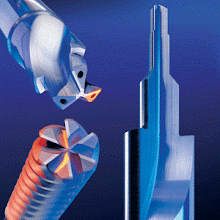Properties of workpiece materials
The term "machinability" refers to either how hard or how easy it is to machine a workpiece material. The criteria that determine the "machinability" of a workpiece material include tool life, difficulty of chip control. attainability of accurate machining. and attainability of acquiring a good surface finish.
Various factors determine whether or not these criteria can be achieved. such as the machining method. the machine being used. the cutting tool and the cutting conditions to be used.
1.Hardness and tool wear
When machining a hard material, the cutting edge of the tool will wear quickly, The opposite is also true when machining a soft material the cutting edge is less prone to wear, but it does become prone to a problem known as welding or "adhesion", This is.a problem where the workpiece actual adheres to or sticks to the cutting edge.
Therefore if the hardness is too high or too soft problems with machining can arise. Generally speaking a hardness of between 180HB-280HB is deemed a hardness region that is termed most suitable for machining.
2.Material strength and cutting resistance
Machining is a process in which the shape of a workpiece is changed by using a cutting edge to remove the unwanted material. "Cutting resistance" is the term given to the difficulty or ease of which this process can be conducted. The term "high material strength" basically means it is "difficult to shape". And as such "high cutting resistance" is ex perienced.
When machining a workpiece material that has high cutting resistance, the cutting edge is prone to plastic deformation, wear and chipping.
3.Work Hardening
Generally, when applying an external force on a metal plastic deformation occurs, and the surface becomes harder. This phenomenon is called "work hardening". When a workpiece material is prone to work hardening. and the depth of cut is too shallow then abrasion wear" tends to occur. However if the depth of cut is too large then notching tends to occur.
4.Cutting temperatures and thermal conductivity
lf a workpiece material has low thermal conductivity then it is difficult for the heat to be radiated away from the cutting edge and as such the cutting edge temperature rapidly increases leading to problems such as plastic deformation and wear of the cutting edge.
On the contrary, when machining a material with high thermal conductivity, the heat of the cuning edge is removed by chips or diffused into the workpiece material. And as such the cutting edge is not affected by heat.
5.Ductility and malleability
Metal with malleability can be rolled thinly into a form like a foil. Metal with ductility can be lengthened thin into a form like wire. Materials with both malleability and ductility are soft materials such as like aluminium and copper.
Care is needed when machining materials with high malleability and ductility as a cutting edge is prone to adhesion and the chips developed tend to elongate.
6.Affinity
Affinity is a term used to describe the ease of which materials tend to bond, or their compatibility with each other. If a workpiece material has high affinity, then when the cutting edge is subject to high cutting edge temperatures, the cutting edge and the workpiece react. This will result in adhesion and larze rake wear.

0 comments:
Post a Comment